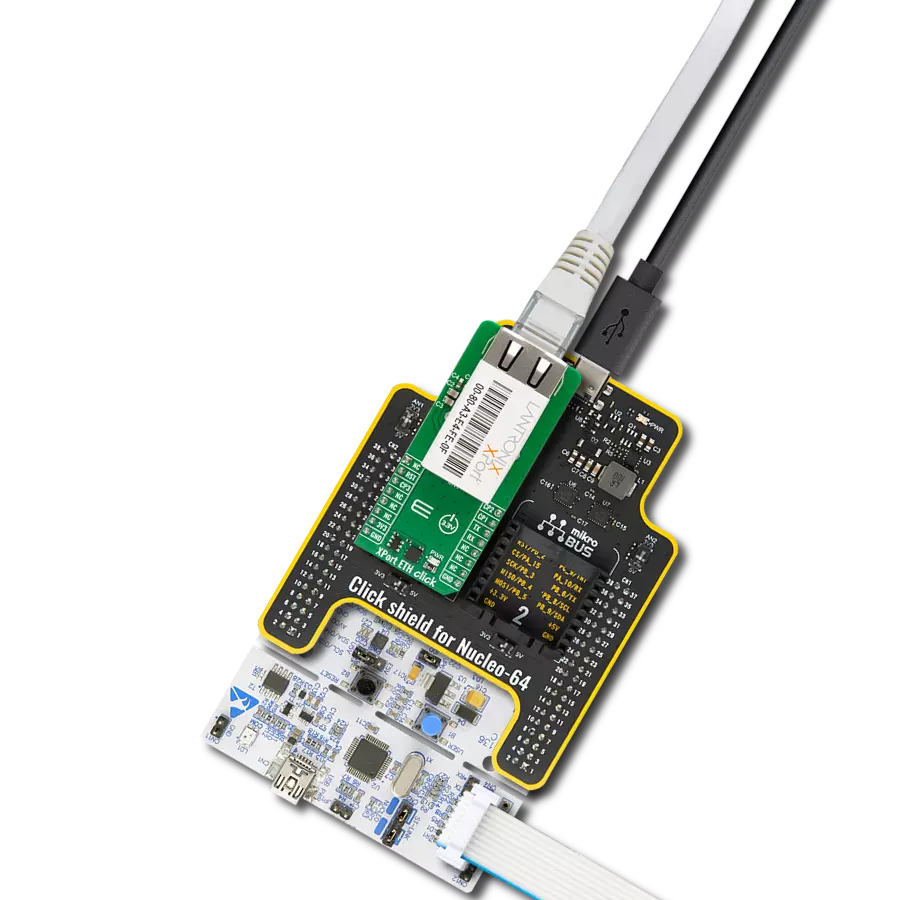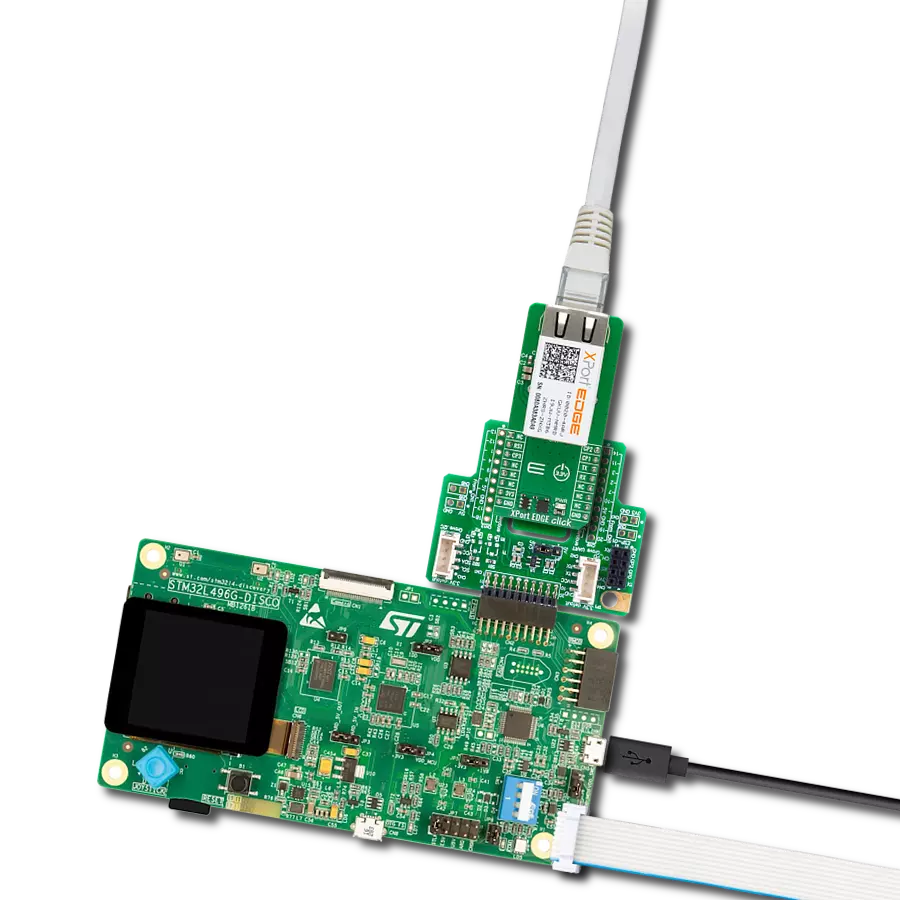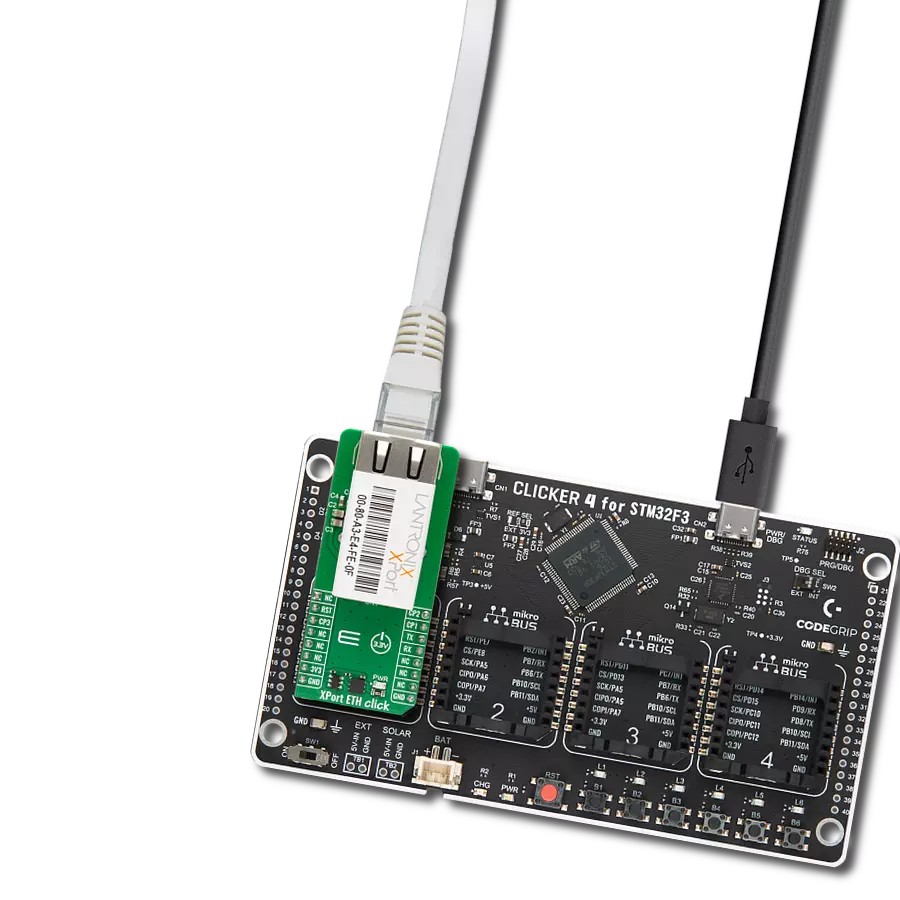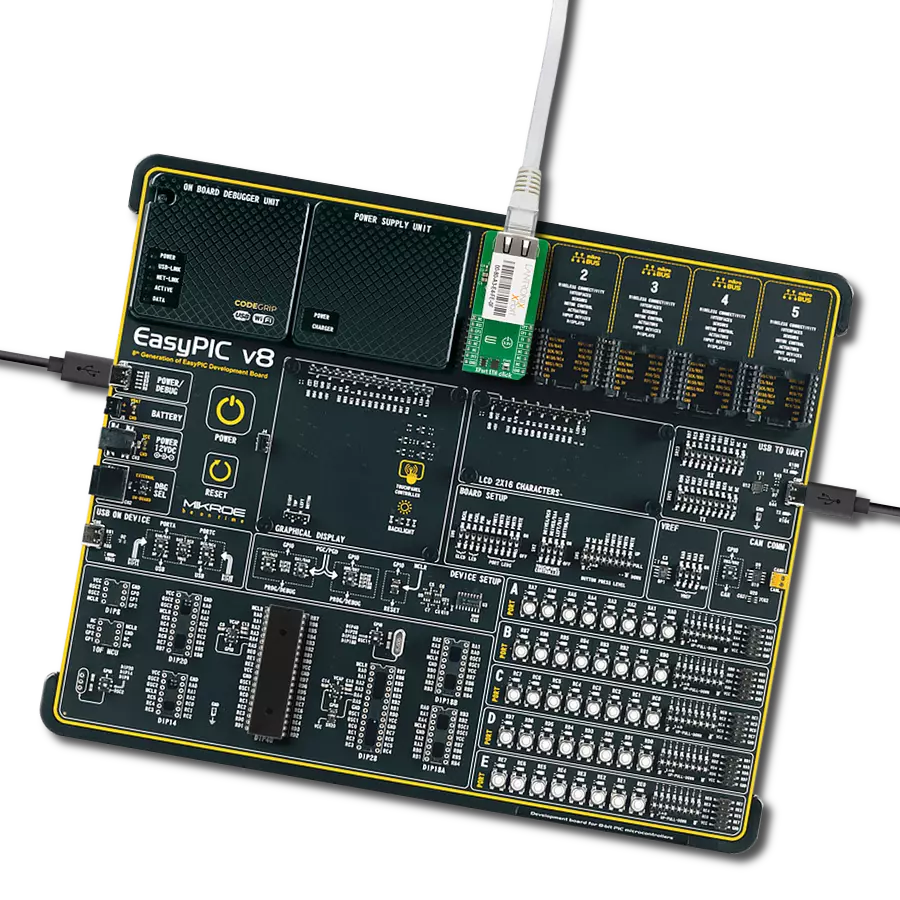Enhance your smart infrastructure and any embedded system requiring reliable device-to-cloud communication
A
A
Hardware Overview
How does it work?
XPort EDGE Click is based on the XPE200100S module from Lantronix, offering a next-generation wired Ethernet gateway and embedded device server in the same compact form factor as the original XPort series. This board is designed to enable secure, reliable, and manageable Ethernet connectivity for industrial and IoT applications by integrating the capabilities of the XPort EDGE platform along with the Percepxion™ cloud-based IoT edge solution. The integrated RJ45 jack includes magnetics and supports 10/100 Mbps Ethernet through an IEEE 802.3-compliant MAC and PHY with HP Auto-MDIX and auto-negotiation for full or half-duplex operation, all within a standard Ethernet connector. The module supports advanced network protocols including IPv4/IPv6, TCP/IP, UDP/IP, DHCP, BOOTP, ARP, ICMP, Auto-IP, DNS, SNMP v1/v2, Telnet, and HTTP, making it suitable for diverse networking scenarios. With built-in support for Lantronix’s customer-proven TruPort® Serial and TruPort® Socket technologies, the XPort EDGE Click ensures secure data
communication through transparent pass-through of serial protocols or multi-session TCP, UDP, and HTTP(S) connections. It supports a maximum serial data rate of 4 Mbps, configurable via software, and it is pre-integrated with the Percepxion™ software platform for remote management, real-time monitoring, and application integration, streamlining deployment in both cloud-connected and on-premise environments. A standout feature is the robust security framework powered by Lantronix’s Infinishield™ Security, which includes secure boot, secure firmware updates (FOTA), secure network attachment via EAPOL, role-based access control, data-at-rest protection for encryption keys and configurations, and fine-grained policy control over network services. These built-in protections minimize the need for additional integration effort while ensuring compliance with modern cybersecurity standards. With its industrial-grade reliability, advanced networking capabilities, and comprehensive device-level security, XPort EDGE Click delivers a complete Ethernet connectivity and
device management solution for modern embedded applications. Communication with the host device is achieved via UART interface and three configurable general-purpose I/O pins (CP1, CP2, and CP3), which can function as flow/modem control lines or general-purpose signals. In addition, the XPort includes 8MB of flash memory for storing firmware and web content, enabling full customization and remote management of connected devices. As mentioned, the module connects directly to an Ethernet network through the RJ45 port. Two bi-color LEDs integrated into the front of the connector provide real-time status indication. This Click board™ can be operated only with a 3.3V logic voltage level. The board must perform appropriate logic voltage level conversion before using MCUs with different logic levels. It also comes equipped with a library containing functions and example code that can be used as a reference for further development.
Features overview
Development board
Nucleo-64 with STM32G474R MCU offers a cost-effective and adaptable platform for developers to explore new ideas and prototype their designs. This board harnesses the versatility of the STM32 microcontroller, enabling users to select the optimal balance of performance and power consumption for their projects. It accommodates the STM32 microcontroller in the LQFP64 package and includes essential components such as a user LED, which doubles as an ARDUINO® signal, alongside user and reset push-buttons, and a 32.768kHz crystal oscillator for precise timing operations. Designed with expansion and flexibility in mind, the Nucleo-64 board features an ARDUINO® Uno V3 expansion connector and ST morpho extension pin
headers, granting complete access to the STM32's I/Os for comprehensive project integration. Power supply options are adaptable, supporting ST-LINK USB VBUS or external power sources, ensuring adaptability in various development environments. The board also has an on-board ST-LINK debugger/programmer with USB re-enumeration capability, simplifying the programming and debugging process. Moreover, the board is designed to simplify advanced development with its external SMPS for efficient Vcore logic supply, support for USB Device full speed or USB SNK/UFP full speed, and built-in cryptographic features, enhancing both the power efficiency and security of projects. Additional connectivity is
provided through dedicated connectors for external SMPS experimentation, a USB connector for the ST-LINK, and a MIPI® debug connector, expanding the possibilities for hardware interfacing and experimentation. Developers will find extensive support through comprehensive free software libraries and examples, courtesy of the STM32Cube MCU Package. This, combined with compatibility with a wide array of Integrated Development Environments (IDEs), including IAR Embedded Workbench®, MDK-ARM, and STM32CubeIDE, ensures a smooth and efficient development experience, allowing users to fully leverage the capabilities of the Nucleo-64 board in their projects.
Microcontroller Overview
MCU Card / MCU
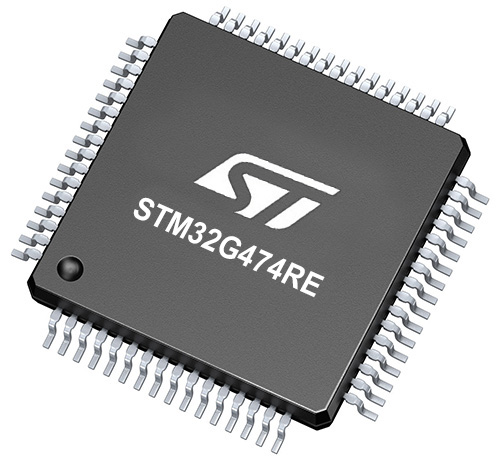
Architecture
ARM Cortex-M4
MCU Memory (KB)
512
Silicon Vendor
STMicroelectronics
Pin count
64
RAM (Bytes)
128k
You complete me!
Accessories
Click Shield for Nucleo-64 comes equipped with two proprietary mikroBUS™ sockets, allowing all the Click board™ devices to be interfaced with the STM32 Nucleo-64 board with no effort. This way, Mikroe allows its users to add any functionality from our ever-growing range of Click boards™, such as WiFi, GSM, GPS, Bluetooth, ZigBee, environmental sensors, LEDs, speech recognition, motor control, movement sensors, and many more. More than 1537 Click boards™, which can be stacked and integrated, are at your disposal. The STM32 Nucleo-64 boards are based on the microcontrollers in 64-pin packages, a 32-bit MCU with an ARM Cortex M4 processor operating at 84MHz, 512Kb Flash, and 96KB SRAM, divided into two regions where the top section represents the ST-Link/V2 debugger and programmer while the bottom section of the board is an actual development board. These boards are controlled and powered conveniently through a USB connection to program and efficiently debug the Nucleo-64 board out of the box, with an additional USB cable connected to the USB mini port on the board. Most of the STM32 microcontroller pins are brought to the IO pins on the left and right edge of the board, which are then connected to two existing mikroBUS™ sockets. This Click Shield also has several switches that perform functions such as selecting the logic levels of analog signals on mikroBUS™ sockets and selecting logic voltage levels of the mikroBUS™ sockets themselves. Besides, the user is offered the possibility of using any Click board™ with the help of existing bidirectional level-shifting voltage translators, regardless of whether the Click board™ operates at a 3.3V or 5V logic voltage level. Once you connect the STM32 Nucleo-64 board with our Click Shield for Nucleo-64, you can access hundreds of Click boards™, working with 3.3V or 5V logic voltage levels.
RJ45 UTP (Unshielded Twisted Pair) cable is a widely used networking cable designed for Ethernet connections in both residential and commercial environments. It features an RJ45 connector at each end, allowing it to interface with routers, switches, computers, and other network devices. The UTP cable consists of four twisted pairs of copper wires, which help reduce electromagnetic interference without the need for additional shielding. These cables are categorized by performance levels, such as Cat5e, Cat6, and Cat6a, each supporting different speeds and bandwidths. Commonly used for wired internet access, data transfer, and VoIP systems, RJ45 UTP cables offer a reliable solution for high-speed network communication. Their plug-and-play design makes installation simple, while the twisted pair construction ensures signal integrity over medium distances. Ideal for structured cabling and LAN setups, RJ45 UTP cables remain a backbone component in modern networking infrastructure.

Used MCU Pins
mikroBUS™ mapper
Take a closer look
Click board™ Schematic

Step by step
Project assembly
Software Support
Library Description
XPort EDGE Click demo application is developed using the NECTO Studio, ensuring compatibility with mikroSDK's open-source libraries and tools. Designed for plug-and-play implementation and testing, the demo is fully compatible with all development, starter, and mikromedia boards featuring a mikroBUS™ socket.
Example Description
This example demonstrates the functionality of the XPort EDGE Click board. It initializes the module, retrieves the device and interface information, performs diagnostic commands such as pinging a specific address, and allows the user to access the device via its web interface. Additionally, it provides a CLI (Command Line Interface) mode to UART terminal for further interaction with the device.
Key functions:
xportedge_cfg_setup- This function initializes Click configuration structure to initial values.xportedge_init- This function initializes all necessary pins and peripherals used for this Click board.xportedge_reset_device- This function resets device by toggling the RST pin state.xportedge_send_cmd- This function sends a command string by using UART serial interface.xportedge_list_commands- This function lists commands at current level by sending the question mark by using UART serial interface.
Application Init
Initializes the logger and the XPort EDGE Click driver, performs a device reset, retrieves device information, and pings the specific address in diagnostics. The application retrieves the device's IP address, enabling the user to connect via a web browser and access the web interface. Finally, it enters CLI mode for advanced command interactions.
Application Task
Continuously monitors UART communication, relaying commands and responses between the XPort EDGE Click board and the logger. This allows real-time interaction with the device through the UART Terminal for configuration and diagnostics.
Open Source
Code example
The complete application code and a ready-to-use project are available through the NECTO Studio Package Manager for direct installation in the NECTO Studio. The application code can also be found on the MIKROE GitHub account.
/*!
* @file main.c
* @brief XPort EDGE Click Example.
*
* # Description
* This example demonstrates the functionality of the XPort EDGE Click board. It initializes the module,
* retrieves the device and interface information, performs diagnostic commands such as pinging a specific
* address, and allows the user to access the device via its web interface. Additionally, it provides a
* CLI (Command Line Interface) mode to UART terminal for further interaction with the device.
*
* The demo application is composed of two sections :
*
* ## Application Init
* Initializes the logger and the XPort EDGE Click driver, performs a device reset, retrieves device
* information, and pings the specific address in diagnostics. The application retrieves the device's IP address,
* enabling the user to connect via a web browser and access the web interface. Finally, it enters CLI mode
* for advanced command interactions.
*
* ## Application Task
* Continuously monitors UART communication, relaying commands and responses between the XPort EDGE Click
* board and the logger. This allows real-time interaction with the device through the UART Terminal for
* configuration and diagnostics.
*
* ## Additional Function
* - static void xportedge_clear_app_buf ( void )
* - static void xportedge_log_app_buf ( void )
* - static err_t xportedge_process ( xportedge_t *ctx )
* - static err_t xportedge_read_response ( xportedge_t *ctx )
*
* @note
* Ensure the XPort EDGE Click board is properly connected to the network.
* The application uses a predefined address to test connectivity via the ping diagnostic command.
*
* @author Stefan Filipovic
*
*/
#include "board.h"
#include "log.h"
#include "xportedge.h"
// Link or IP address for pinging
#define ADDRESS_TO_PING "https://www.mikroe.com"
// Application buffer size
#define APP_BUFFER_SIZE 200
#define PROCESS_BUFFER_SIZE 100
static xportedge_t xportedge;
static log_t logger;
static uint8_t app_buf[ APP_BUFFER_SIZE ] = { 0 };
static int32_t app_buf_len = 0;
/**
* @brief XPort EDGE clearing application buffer.
* @details This function clears memory of application buffer and reset its length.
* @note None.
*/
static void xportedge_clear_app_buf ( void );
/**
* @brief XPort EDGE log application buffer.
* @details This function logs data from application buffer to USB UART.
* @note None.
*/
static void xportedge_log_app_buf ( void );
/**
* @brief XPort EDGE data reading function.
* @details This function reads data from device and concatenates data to application buffer.
* @param[in] ctx : Click context object.
* See #xportedge_t object definition for detailed explanation.
* @return @li @c 0 - Read some data.
* @li @c -1 - Nothing is read.
* See #err_t definition for detailed explanation.
* @note None.
*/
static err_t xportedge_process ( xportedge_t *ctx );
/**
* @brief XPort EDGE read response function.
* @details This function waits for a response message, reads and displays it on the USB UART.
* @param[in] ctx : Click context object.
* See #xportedge_t object definition for detailed explanation.
* @return @li @c 0 - OK response.
* @li @c -2 - Timeout error.
* See #err_t definition for detailed explanation.
* @note None.
*/
static err_t xportedge_read_response ( xportedge_t *ctx );
void application_init ( void )
{
log_cfg_t log_cfg; /**< Logger config object. */
xportedge_cfg_t xportedge_cfg; /**< Click config object. */
/**
* Logger initialization.
* Default baud rate: 115200
* Default log level: LOG_LEVEL_DEBUG
* @note If USB_UART_RX and USB_UART_TX
* are defined as HAL_PIN_NC, you will
* need to define them manually for log to work.
* See @b LOG_MAP_USB_UART macro definition for detailed explanation.
*/
LOG_MAP_USB_UART( log_cfg );
log_init( &logger, &log_cfg );
log_info( &logger, " Application Init " );
// Click initialization.
xportedge_cfg_setup( &xportedge_cfg );
XPORTEDGE_MAP_MIKROBUS( xportedge_cfg, MIKROBUS_1 );
if ( UART_ERROR == xportedge_init( &xportedge, &xportedge_cfg ) )
{
log_error( &logger, " Communication init." );
for ( ; ; );
}
log_printf( &logger, "*** Reset Device ***" );
xportedge_reset_device ( &xportedge );
xportedge_read_response ( &xportedge );
log_printf( &logger, "\r\n-----------------------------\r\n" );
log_printf( &logger, "*** Get Device Info ***" );
xportedge_send_enter ( &xportedge );
xportedge_read_response ( &xportedge );
xportedge_send_cmd ( &xportedge, XPORTEDGE_CMD_STATUS );
xportedge_read_response ( &xportedge );
xportedge_send_cmd ( &xportedge, XPORTEDGE_CMD_STATUS_DEVICE );
xportedge_read_response ( &xportedge );
xportedge_send_cmd ( &xportedge, XPORTEDGE_CMD_SHOW );
xportedge_read_response ( &xportedge );
log_printf( &logger, "\r\n-----------------------------\r\n" );
log_printf( &logger, "*** Go Back to Status Level ***" );
xportedge_send_enter ( &xportedge );
xportedge_read_response ( &xportedge );
xportedge_send_cmd ( &xportedge, XPORTEDGE_CMD_EXIT );
xportedge_read_response ( &xportedge );
log_printf( &logger, "\r\n-----------------------------\r\n" );
log_printf( &logger, "*** Get Interface Status and IP Address ***\r\n" );
log_printf( &logger, "*** Connect to Listed IP Address Through Web Browser to Access Web Interface ***" );
xportedge_send_enter ( &xportedge );
xportedge_read_response ( &xportedge );
xportedge_send_cmd ( &xportedge, XPORTEDGE_CMD_STATUS_INTERFACE_ETH0 );
xportedge_read_response ( &xportedge );
xportedge_send_cmd ( &xportedge, XPORTEDGE_CMD_SHOW );
xportedge_read_response ( &xportedge );
log_printf( &logger, "\r\n-----------------------------\r\n" );
log_printf( &logger, "*** Go Back to Status Level ***" );
xportedge_send_enter ( &xportedge );
xportedge_read_response ( &xportedge );
xportedge_send_cmd ( &xportedge, XPORTEDGE_CMD_EXIT );
xportedge_read_response ( &xportedge );
log_printf( &logger, "\r\n-----------------------------\r\n" );
log_printf( &logger, "*** Ping %s ***", ( char * ) ADDRESS_TO_PING );
xportedge_send_enter ( &xportedge );
xportedge_read_response ( &xportedge );
xportedge_send_cmd ( &xportedge, XPORTEDGE_CMD_STATUS_DIAGNOSTICS );
xportedge_read_response ( &xportedge );
xportedge_send_cmd ( &xportedge, XPORTEDGE_CMD_STATUS_DIAGNOSTICS_PING );
xportedge_read_response ( &xportedge );
xportedge_send_cmd ( &xportedge, XPORTEDGE_CMD_STATUS_DIAGNOSTICS_PING_HOST( ADDRESS_TO_PING ) );
xportedge_read_response ( &xportedge );
log_printf( &logger, "\r\n-----------------------------\r\n" );
log_printf( &logger, "*** Go Back to ROOT Level ***" );
xportedge_send_enter ( &xportedge );
xportedge_read_response ( &xportedge );
xportedge_send_cmd ( &xportedge, XPORTEDGE_CMD_EXIT );
xportedge_read_response ( &xportedge );
xportedge_send_cmd ( &xportedge, XPORTEDGE_CMD_EXIT );
xportedge_read_response ( &xportedge );
xportedge_send_cmd ( &xportedge, XPORTEDGE_CMD_EXIT );
xportedge_read_response ( &xportedge );
log_printf( &logger, "\r\n-----------------------------\r\n" );
log_printf( &logger, "*** List ROOT Level Commands and Switch to CLI Terminal ***\r\n" );
log_printf( &logger, "*** Now CLI Commands are Input from the UART Terminal ***" );
xportedge_send_enter ( &xportedge );
xportedge_read_response ( &xportedge );
xportedge_list_commands ( &xportedge );
xportedge_read_response ( &xportedge );
}
void application_task ( void )
{
app_buf_len = uart_read( &logger.uart, app_buf, PROCESS_BUFFER_SIZE );
if ( app_buf_len > 0 )
{
uart_write ( &xportedge.uart, app_buf, app_buf_len );
xportedge_clear_app_buf ( );
}
app_buf_len = uart_read( &xportedge.uart, app_buf, PROCESS_BUFFER_SIZE );
if ( app_buf_len > 0 )
{
uart_write ( &logger.uart, app_buf, app_buf_len );
xportedge_clear_app_buf ( );
}
}
int main ( void )
{
/* Do not remove this line or clock might not be set correctly. */
#ifdef PREINIT_SUPPORTED
preinit();
#endif
application_init( );
for ( ; ; )
{
application_task( );
}
return 0;
}
static void xportedge_clear_app_buf ( void )
{
memset( app_buf, 0, app_buf_len );
app_buf_len = 0;
}
static void xportedge_log_app_buf ( void )
{
for ( int32_t buf_cnt = 0; buf_cnt < app_buf_len; buf_cnt++ )
{
log_printf( &logger, "%c", app_buf[ buf_cnt ] );
}
}
static err_t xportedge_process ( xportedge_t *ctx )
{
uint8_t rx_buf[ PROCESS_BUFFER_SIZE ] = { 0 };
int32_t overflow_bytes = 0;
int32_t rx_cnt = 0;
int32_t rx_size = xportedge_generic_read( ctx, rx_buf, PROCESS_BUFFER_SIZE );
if ( ( rx_size > 0 ) && ( rx_size <= APP_BUFFER_SIZE ) )
{
if ( ( app_buf_len + rx_size ) > APP_BUFFER_SIZE )
{
overflow_bytes = ( app_buf_len + rx_size ) - APP_BUFFER_SIZE;
app_buf_len = APP_BUFFER_SIZE - rx_size;
for ( int32_t buf_cnt = 0; buf_cnt < overflow_bytes; buf_cnt++ )
{
log_printf( &logger, "%c", app_buf[ buf_cnt ] );
}
memmove ( app_buf, &app_buf[ overflow_bytes ], app_buf_len );
memset ( &app_buf[ app_buf_len ], 0, overflow_bytes );
}
for ( rx_cnt = 0; rx_cnt < rx_size; rx_cnt++ )
{
if ( rx_buf[ rx_cnt ] )
{
app_buf[ app_buf_len++ ] = rx_buf[ rx_cnt ];
}
}
return XPORTEDGE_OK;
}
return XPORTEDGE_ERROR;
}
static err_t xportedge_read_response ( xportedge_t *ctx )
{
uint32_t timeout_cnt = 0;
uint32_t timeout = 30000;
while ( 0 == strstr( app_buf, XPORTEDGE_CMD_TERMINAL ) )
{
xportedge_clear_app_buf ( );
xportedge_process( ctx );
xportedge_log_app_buf ( );
if ( timeout_cnt++ > timeout )
{
return XPORTEDGE_ERROR_TIMEOUT;
}
Delay_ms ( 1 );
}
timeout_cnt = 0;
timeout = 100;
xportedge_clear_app_buf ( );
while ( timeout_cnt++ < timeout )
{
if ( XPORTEDGE_OK == xportedge_process( ctx ) )
{
timeout_cnt = 0;
}
xportedge_log_app_buf ( );
xportedge_clear_app_buf ( );
Delay_ms ( 1 );
}
return XPORTEDGE_OK;
}
// ------------------------------------------------------------------------ END
Additional Support
Resources
Category:Ethernet




















